What’s the firepower like for the Army’s new rifle?
ABERDEEN PROVING GROUND, Md. — The Army’s new rifle, automatic rifle and fire control provide a more accurate, farther reaching and deadlier combination of weapons than a squad or platoon currently carries.
During a September media event held at Aberdeen Proving Ground in Maryland by Program Executive Office Soldier, participants shot both the Next Generation Squad Weapon XM7 rifle and the XM250 automatic rifle — the Army’s replacements for M4 and M249 Squad Automatic Weapon for the close combat force. That group includes infantry, scouts, combat engineers and special operations forces.
At the event, officials announced a unit in the 101st Airborne Division had received the weapons that week and would undergo initial training on the weapons later in the month, followed by limited-user tests in October. A squad from the 75th Ranger Regiment will also participate in testing the weapons.
Primarily, they’ll be evaluating how small units and soldiers employ the weapons, what adjustments they make to their kit and procedures, and how mobile they are in a side-by-side comparison with the legacy M4 and M249 SAW, said Lt. Col. Micah Rue, the product manager for weapons at PEO Soldier.
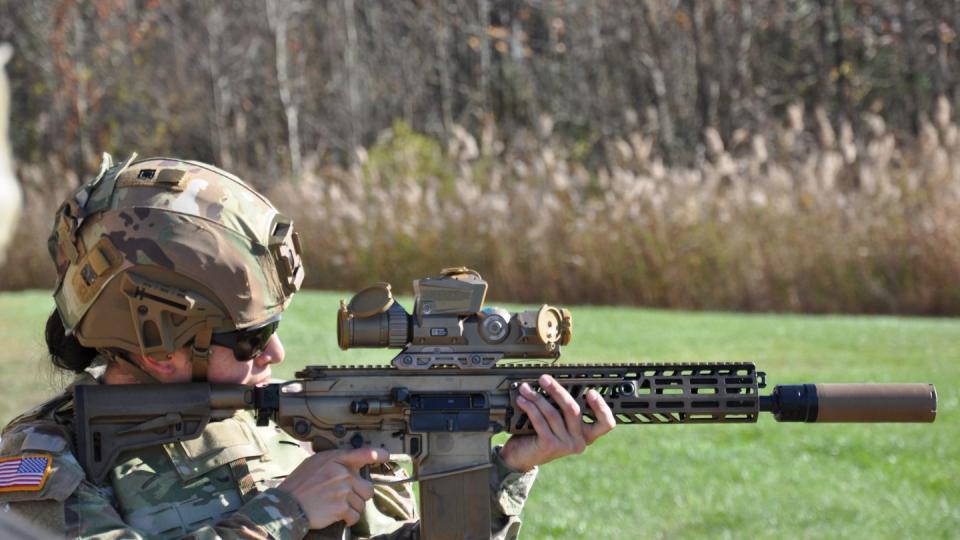
The first unit equipped will also be in the 101st Airborne Division. That’s happening in the second quarter of fiscal 2024.
The XM250 is a belt-fed, air-cooled, lightweight, gas-operated, select fire, suppressed light machine gun that fires from the open-bolt position.
The XM7 is a piston-driven, modular, select fire, magazine-fed, suppressed rifle. The M4 is a carbine version of the original M16 rifle. The new rifle has ambidextrous controls, an AR-style charging handle and a left-side charging handle. It comes with a two-position adjustable gas valve, collapsible folding butt stock, match-grade two-stage trigger, free-floating MLOK handguard and a full Picatinny rail system.
The trigger requires extra pull for firing — a safety feature.
The MLOK handguard and Picatinny rail allow for accessories to be added to the weapon such as aiming lasers and foregrips.
Both weapons include quick-detach suppressors that reduce visible flash and sound and also decrease gases released that flow back to the weapon user, according to PEO Soldier.
The weapons fire a new 6.8mm “intermediate caliber” round, and both use the 1-8x magnified XM157 fire control, or rifle optic, that comes equipped with a ballistics computer to provide aiming assistance to the shooter.
The optic runs on two CR132 batteries and operates for 250 hours on the low power mode setting.
While the aiming assistance provided by the fire control is evident, as seen by participants on the range, it doesn’t eliminate the need for marksmanship training.
“The fundamentals of marksmanship remain the same, even with this new weapon,” said Lt. Col. Trond Ruud, product manager for small arms fire control at PEO Soldier.
The XM1186 general-purpose ammunition in 6.8mm builds on enhanced-performance round work done over years with the 5.56mm. Soldiers will also receive the reduced range, blank, tracer and marking rounds.
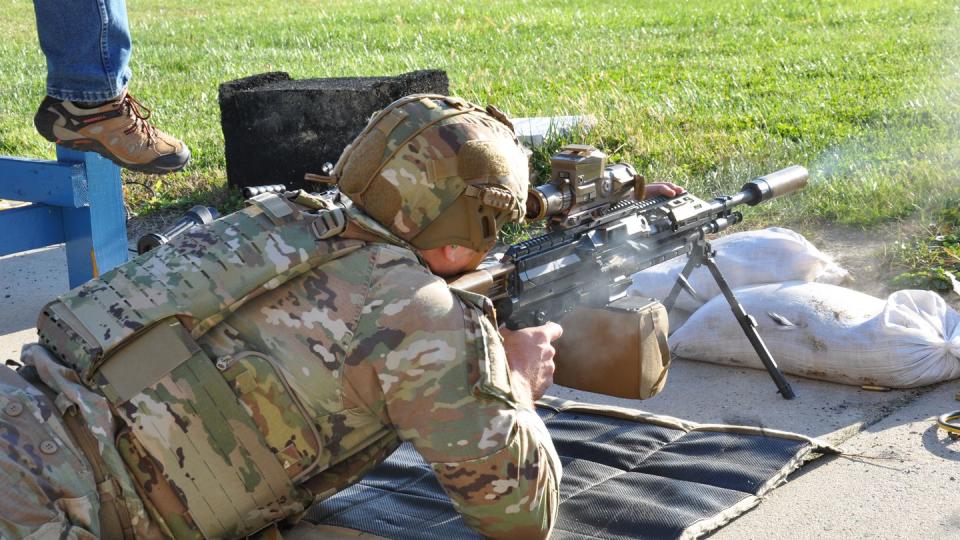
The reduced range rounds are made so soldiers with the Next Generation Squad Weapon can fire on existing ranges designed for the 5.56mm. The marking rounds provide force-on-force shooting, like the chalk rounds used with weapons for decades.
According to PEO Soldier, some of the improvements of the 6.8mm over 5.56mm include:
Dramatically improved hard target performance.
Improved, consistent effects against soft targets and close-quarters battle performance.
Significant increase in range of consistent effects against all targets.
Extremely effectiveness against a wide range of targets — a true general-purpose round.
Maintains a lead-free projectile.
On a range dotted with reactive, human silhouette targets at intervals between 50 meters and 500 meters, participants shot magazines in seated and standing positions from the XM7 and seated on a bench with the XM250.
The optics setup and 6.8mm trajectory meant the weapons fired flat with little to no optics adjustments out to 300 meters. Beyond that distance, the shooter could simply press a button on the XM157 optic or on a handrail accessible control that would instantaneously provide three dots to adjust the aim point.
The 10-year contract for the Sig Sauer weapons systems has a ceiling value of $4.5 billion; the cost ceiling for the Vortex Optics/Sheltered Wings optic is set at $2.7 billion.
The XM157 is a magnified, direct-view optic with an integrated laser-range finder, digital compass, environmental sensors, visible and infrared aiming lasers, ballistics solver, and digital display overlay with wireless communication, according to PEO Soldier. The device can be loaded with any ballistics configuration in the Army’s arsenal or future ballistics data to provide the same capabilities on other small caliber weapons systems, officials said.
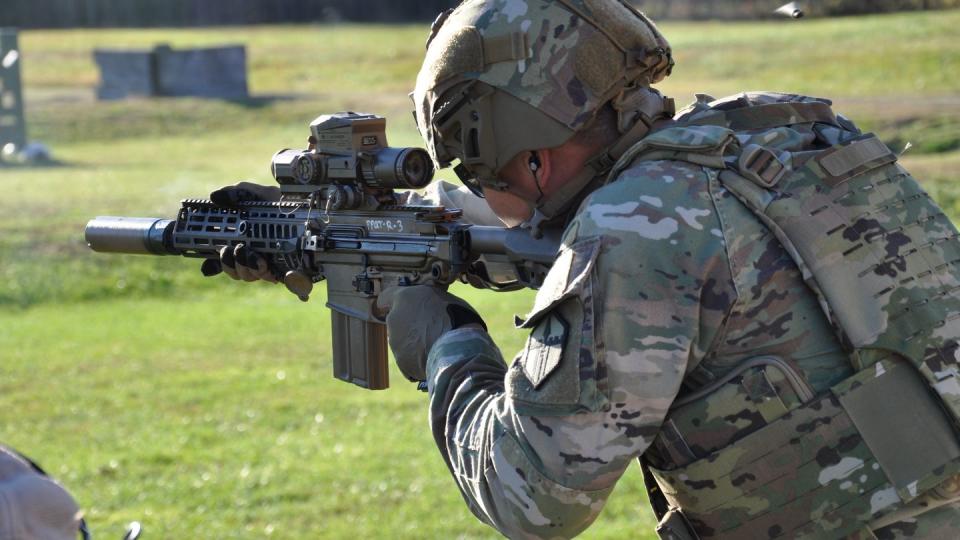
Both weapons were suppressed. Shooters had the option to fire the XM7 suppressed or unsuppressed.
In a demonstration prior to participant shooting, a soldier fired the XM250 on bursts through cinder blocks and struck the target behind the blocks at about the 300-meter range. Rounds pierced the cinder blocks and struck the target.
In a side-by-side comparison, the SAW shooter fired at the blocks; only one round partially penetrated the cinder block but didn’t have an effect on the covered target.
That demonstration is an example of one of multiple efforts that drove the push for a new round for squad-level shooters — a more lethal round on target with further reach. Or what Rue called “turning cover into concealment.”
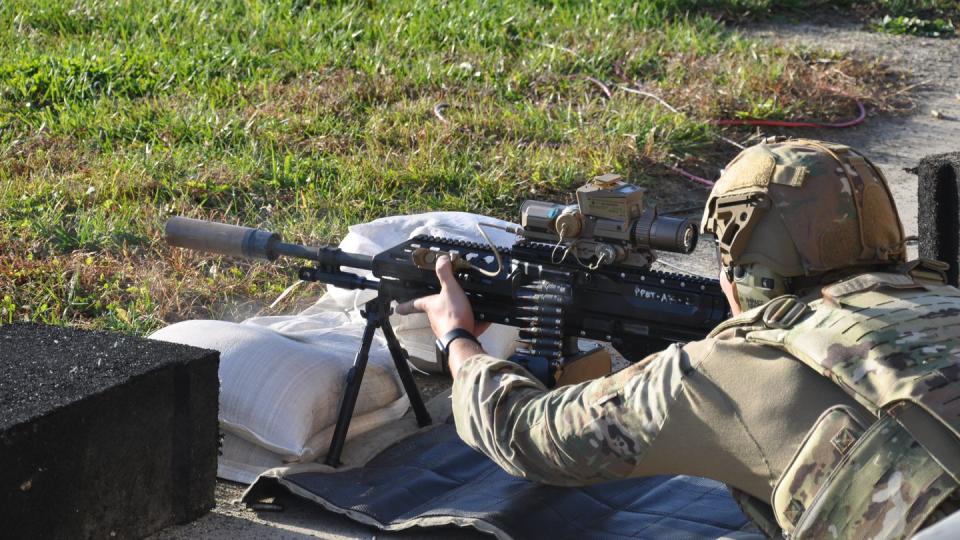
The capability will deny protection in certain terrain, meaning adversaries can’t consider themselves safe simply by hiding behind a wall.
The 6.8mm is built around a government-designed bullet, which the Army Marksmanship Unit helped create, in a casing that provides considerably more powder for greater velocities than the existing 5.56mm. The 5.56mm round was brought into the force to provide a higher volume of fires with an easier recoil for closer engagements, a shift of more than half a century of .30-caliber rounds dominating the squad firepower from World War I through the Korean War.
But the round, designed out of the .223-caliber varmint hunting round, was originally intended for small game shooting and has had its critics, as has the M16 and its variants since its adoption in the 1960s.
Feedback from soldiers during combat operations in Afghanistan and a 2017 small arms ammunition configuration study provided support for an intermediate caliber option.
According to PEO Soldier, key takeaways from that study include:
Aim error reduction has the highest impact on performance.
Caliber isn’t as important as once believed; it is a secondary performance driver.
Fire control is key.
Advanced bullet technology matters.
Ballistic energy on target provides better lethal effects.
In the early 1900s both the British and Japanese militaries used a 6mm-range caliber, which is most comparable on the civilian side to .270-caliber ammunition. The weapon is heavier — 3 pounds more than the M4 — and the felt recoil is slightly more than the M4. But even with minimal familiarization, the accuracy was as good at close range and better at ranges beyond 300 meters than with the M4.
But the M250 is 2.7 pounds lighter than the SAW. Troops will carry fewer rounds with both new systems — 140 for the XM7 compared to 210 for the M4, and 400 rounds for the XM250 compared with the 600 rounds for the SAW.
However, lethality experts in the Army have repeatedly said the increased effectiveness and accuracy of the weapons and round will mean soldiers can fire fewer rounds with the same or better results.
A standard XM7 load will include seven magazines. The reduced rounds will free up space on soldier kit. The Army has produced new gear carriage systems compatible with the weapon. That’s another piece of what developers will be watching as soldiers test this out — how does it affect the rest of their kit and how they perform, Rue said.
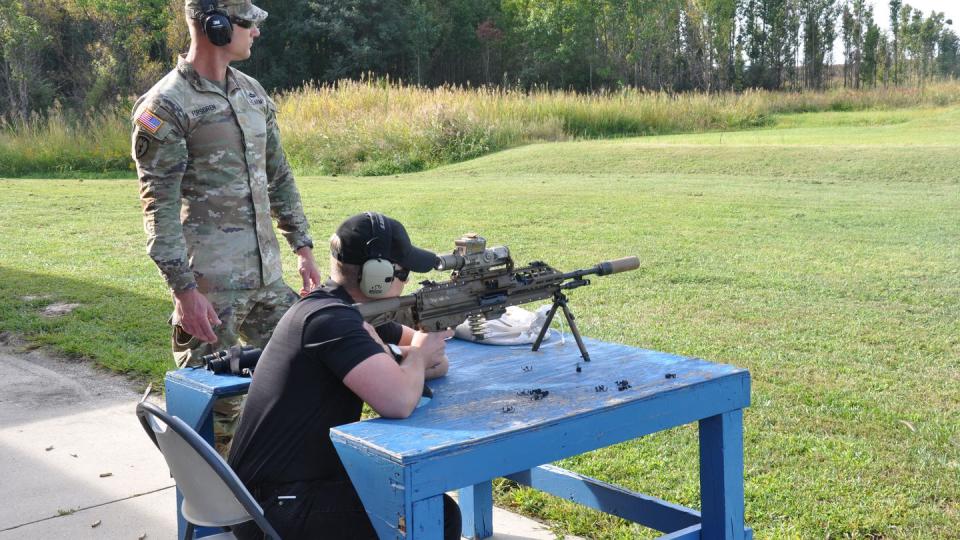
During the recent range shooting event, an Army Times editor successfully hit targets with the XM7 on mostly first, sometimes second shots, both seated and standing.
As units continue to test the weapons, the Army has scheduled a cold weather test for early next year, followed by a tropics test, then a hot weather test. Operational assessments of the systems are planned for early fiscal 2025.

